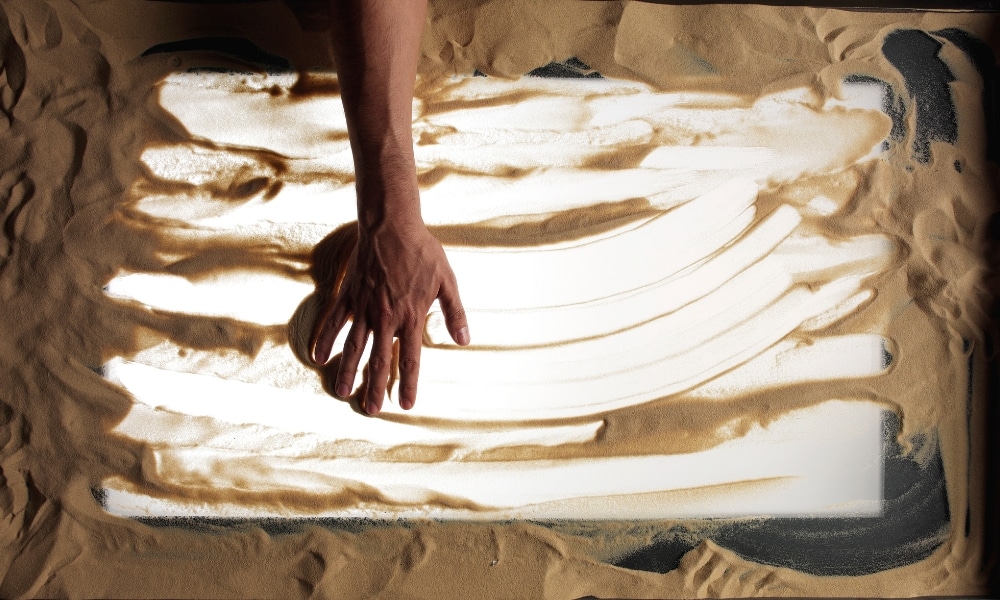Skip To Section
Sand tray therapy, a unique and powerful therapeutic approach, offers individuals battling addiction an expressive and imaginative path toward healing. Rooted in the principles of play therapy, this modality transcends traditional talk therapies by engaging clients in a hands-on, visual, and kinetic experience.
Sand tray therapy works in conjunction with traditional talk therapy to help a person heal past trauma and build up resources that are necessary for other parts of life. This type of therapy is known to be especially helpful for children and teens. It can also be beneficial for people of all ages struggling with substance abuse and addiction. As a type of expressive therapy, it can also be useful when a client and therapist do not speak the same language, share the same culture, or struggle to communicate due to a myriad of other reasons.

History of Sand Tray Therapy
Sand tray therapy came about in the late 1950s under psychologist Dora Kalff. She was tutored by child psychologist Margaret Lowenfeld, who had come up with her own form of sand therapy as well. Kalff used Eastern philosophies and training in Karl Jung’s methods in order to refine her mentor Lowenfeld’s methods.
The idea is to use a tray with miniatures to help clients express themselves. The therapist guides the client so they can understand the link between what they have created in the sand tray and their real world.
How Does Sand Tray Therapy Work?
Sand tray therapy involves a sandbox and a wide array of miniature figures, allowing individuals to construct their own worlds or scenes that reflect personal thoughts, struggles, experiences, or emotions. This creative process not only facilitates open communication but also helps unearth underlying issues contributing to addictive behaviors.
By manipulating symbols in the sand, clients can externalize complex feelings and gain insights into their addiction journey in a safe and supportive environment. Sand tray therapy embodies the belief that through creative expression, individuals can navigate the intricacies of recovery with newfound clarity and empowerment.
What Are Sand Tray Therapy Sessions Like?
Sand tray therapy can include a variety of tools. A sand tray can be of any size, but Dora Kalff specified that they should be 19.5 inches x 28.5 inches x 3 inches to provide a controlled space where a person could use their toys, tools, and miniatures.
Clients are encouraged to use the toys and miniatures available so they can create a small version of a world that displays something they are living at the moment. The client receives guidance, but they are not interrupted during the process.
Once the client is done, the therapist may decide to talk about how things were put together. The discussion might focus on how the items were arranged and what this could mean. Items may also be arranged while talking to the therapist.
Benefits of Sand Tray Therapy
Most research focuses on sand therapy’s effects on children and teens. The benefits of San tray therapy include:
- Sand tray therapy can be useful even in groups settings and with children who have observed domestic violence in the past. The study observed results after two therapeutic sessions per week in 16 instances with positive results.
- Another study saw improvements in the behavior of a 3-year-old child who was HIV-positive.
- A different study showed that patients with Asperger’s were able to improve their communication skills and achieve better mental health after sand tray therapy.
Some clients had as many as 50 sessions, and others had as few as 6. They all improved during the course of these sessions.
What Does This Type of Play Therapy Aim to Accomplish?
Sand tray therapy has been useful for clients who have been through abusive or traumatic experiences. It can be just as useful in adults as it is in children. Data shows that clients benefit by de-stressing and being able to express themselves.
The idea is to provide a safe space for the client to work while discussing things as they come up. This way, they can eventually come up with solutions to problems and gain a better understanding of their circumstances.
In one study, a client who had abused drugs was struggling to talk about their emotions or identify them. The client was eventually able to use the miniatures to explore these feelings, and this helped them to resist the urge to abuse substances.
Are There Any Similar Therapies?
Sand tray therapy is innovative in that it allows people to allude to problems and can be helpful for people who prefer nonverbal communication.
There are other types of therapies that focus on nonverbal methods or use metaphors as a way to help clients. These include:
- Play therapy. Commonly applied to clients who are between 3 and 12 years old, play therapy can also be helpful for adults. A few limitations or rules are imposed, but generally, the client plays in a comfortable area while the therapist makes observations. The end goal is to help the client respect others and come up with solutions to problems in a positive environment.
- Art therapy. Art is useful in helping clients deal with mental health issues while decreasing their stress levels. It can also help clients communicate their emotions while exploring their personality a bit.Collage, drawing, painting, and even sculpture can be used to help clients who have lived through trauma, a mental health condition, abuse, depression, or anxiety. In art therapy, the goal is to help clients create images that come from within instead of just making observations about the world around them.
- Solution-focused brief therapy (SFBT). This type of therapy surfaced in the 1970s and 1980s. It was pioneered by Insoo Kim Berg and Steve de Shazer. It focuses more on what the client has done correctly, which is different from therapies that focus mostly on bad decisions or problems. SFBT focuses on simple solutions to problems. As a short-term therapy, it is not designed to last a long time.
Sand Tray Therapy in Addiction Treatment
Sand tray and other complementary therapies can help those in recovery from substance abuse, but they shouldn’t be used as a primary form of treatment. They work best when used in conjunction with traditional substance abuse treatment, such as the use of medications and talk therapy.
In fact, recovery often depends on receiving a variety of approaches during treatment.
- Medication-assisted treatment is available for people who struggle with addiction to certain drugs, like opioids. For opioid use disorders, methadone or buprenorphine may be prescribed to manage withdrawal symptoms and reduce cravings. Naloxone can prevent overdoses and is also available.There are also medications for people who are addicted to alcohol or tobacco. These options can decrease cravings and mitigate withdrawal.
- Behavioral therapy in an individual or group setting is essential to achieving necessary changes that support ongoing abstinence. This therapy teaches clients how to prevent relapse and improve personal and professional relationships.
- Additional programs to address legal, financial, or even educational needs may be provided. Clients may also be dealing with unaddressed co-occurring mental health issues that require further treatment.
All the above options may be used to complement sand tray therapy. When multiple therapy options are used together, clients often experience more grown in recovery.

Holistic Treatment for Addiction
If you or a loved one is struggling with addiction, our holistic addiction treatment centers provide complementary therapies like sandy tray therapy to promote overall wellness and healing. Our highly trained staff will work with you to develop a personalized treatment plan focused on your unique needs and goals.
At Footprints to Recovery, we believe that healing the mind, body, and spirit is essential for achieving long-term recovery. That’s why we offer a variety of alternative therapies in addition to traditional evidence-based treatments. For more information about our holistic treatment services, call us today!
Our admissions team is available 24/7 to listen to your story and help you get started with the next steps.








